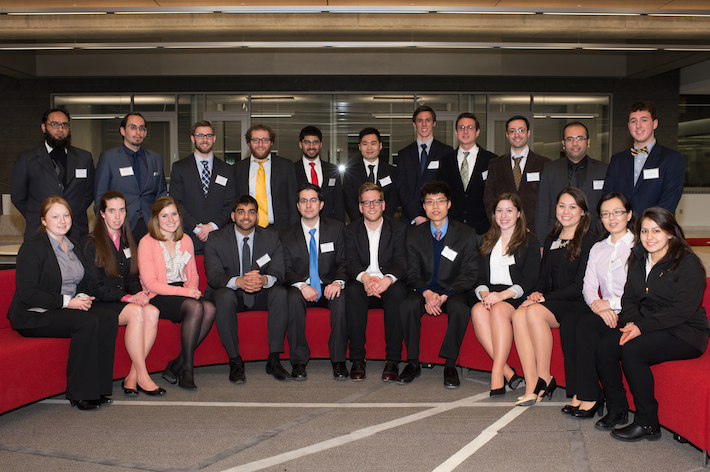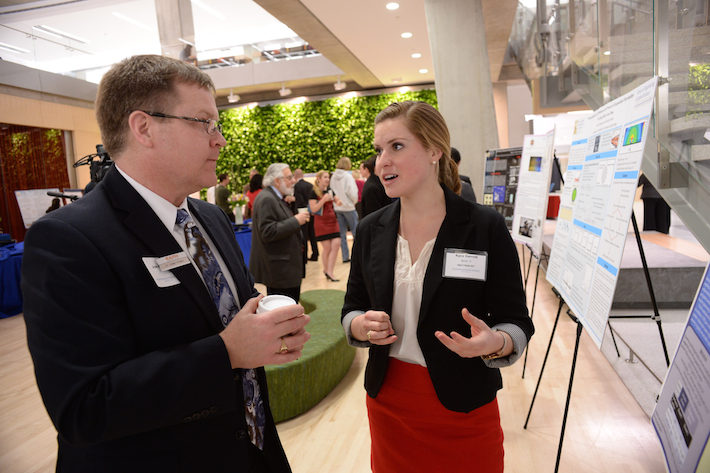A record number of students—more than 120—competed in the ninth annual Research and Development Showcase at the George Washington University last week, a significant jump in participants from previous years.
Undergraduate and graduate students presented their research to panels of faculty, corporate and alumni judges Wednesday. The winning projects, which ranged from a study of how chemicals found in plastic can affect the heart to the development of a method to capture single cells to better study disease, were announced during a ceremony Thursday at Science and Engineering Hall.
Award recipients and their mentors stemmed from all six departments in the School of Engineering and Applied Science (SEAS) and received a combined $35,000 in prize money.
“The level of sophistication of the student work seems to get higher each year. These students are bright and highly motivated,” said Provost Steven Lerman. “I think the extraordinary creativity of our students is going to move to even greater levels as they inhabit Science and Engineering Hall.”
Lead judge Matt Kay, an associate professor in the Department of Biomedical Engineering, attributed the growth of the showcase to Dean David Dolling’s recent faculty hires and the school’s burgeoning research profile.
“Dean Dolling has done an excellent job promoting research and hiring faculty who are the best in their fields. More SEAS professors are receiving grants, and we’re recruiting better graduate students,” Dr. Kay said. “And research programs developed five or six years ago are really beginning to mature.”
SEAS made two changes to this year’s competition: Judges divided the graduate student research prizes into “experimental” and “theoretical” categories and also required participants to submit two-page project abstracts in the fall, which were scored along with students’ showcase presentations.
“The abstracts gave us some deeper insight into the technical sophistication of the work,” Dr. Kay said.

Finalists in the School of Engineering and Applied Science's ninth annual Research and Development Showcase stemmed from all six engineering departments. (Photo Credit: Eleanor Kaufman)
The Winners
In the experimental category, graduate students Nathan Castro, Allan Guan and Margaret Nowicki tied for first place and each received $4,000.
Mr. Castro and Ms. Nowicki, Ph.D. students in the Department of Mechanical and Aerospace Engineering, both presented projects related to 3-D bioprinting techniques to regenerate complex bone tissue.
Mr. Guan, a Ph.D. student in the Department of Biomedical Engineering, created a microfluidic device that manipulates and controls small volumes of liquid in order to trap single cells at 100 percent efficiency. This new design method could aid scientists in studying single cells to investigate disease.
Chris Cox, a Ph.D. student in the Department of Mechanical and Aerospace Engineering, won first place in the theoretical category. He received $5,000 for developing a fast algorithm for solving viscous flow in air, water or blood, The flow solver could, for example, help doctors decide whether to medically intervene in patients who have stenosis, an abnormal narrowing in a blood vessel.
Maryam Yammahi, a Ph.D. student in the Department of Computer Science, was awarded the $2,000 entrepreneurship prize for developing a new technology that addresses “Big Data” challenges. The intelligent “Software-Defined-Storage” model enables users to more quickly and efficiently store and process data.
Akhil Chandra, a junior majoring in biomedical engineering, won the $2,000 prize for undergraduate research. Working with Dr. Kay and Nikki Posnack, a researcher in the School of Medicine and Health Sciences, Mr. Chandra investigated how exposure to Bisphenol A (BPA), found in many consumer products, can significantly reduce heart rate and the heart’s ability to pump blood.
Mr. Chandra would like to one day create devices that could alleviate heart dysfunction. He said he values his undergraduate research experiences, because he learned to independently find solutions when experiments did not go as planned.
“I would spend hours and hours in the lab and nothing would go right. It was very frustrating. But I eventually got the hang of things, and it’s been great to see how much I’ve grown since then,” he said. “Doing research has enhanced my critical thinking and taught me to think on my feet.”
Following a day of poster presentations, Arati Prabhakar, director of the Defense Advanced Research Projects Agency, gave a keynote speech to the showcase participants. Dr. Prabhakar presented three of DARPA’s current projects, including new methods to deliver satellites in space, identify sex traffickers around the world and revolutionize prosthetic limbs that can be moved by the human mind.
Thursday’s showcase also featured an expert panel of speakers from NASA, HP Enterprise Services, the World Bank Group and Leidos to discuss America’s cybersecurity preparedness. SEAS alumnus and AgileTrailblazers founder Naeem Hussain, M.S. ’99, moderated the talk.
“No matter what field you go into, if you understand cyber security you will be a differentiator. Cybersecurity is going to be a part of whatever you decide to do with your careers,” said Roopangi Kadakia, web services executive at NASA. “It’s an amazing career opportunity. How many other careers challenge you every other minute?”
To see a complete list of winners, honorable mentions and their advisers, visit the SEAS website.


